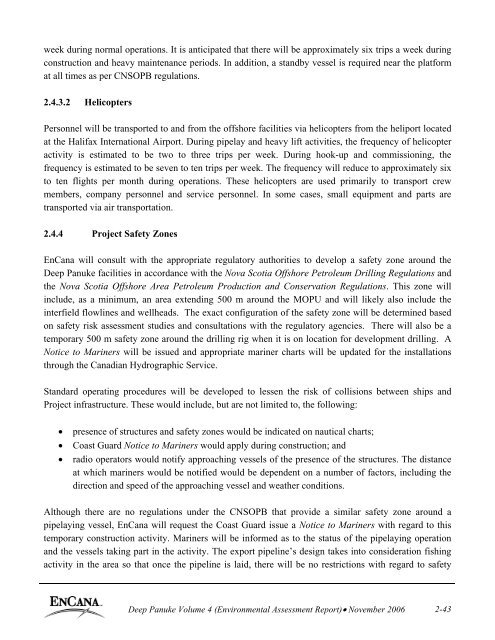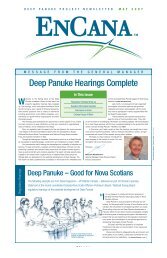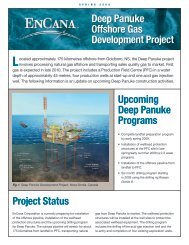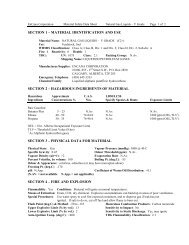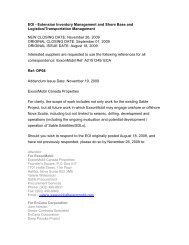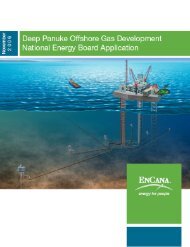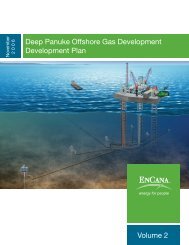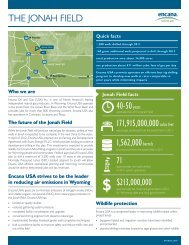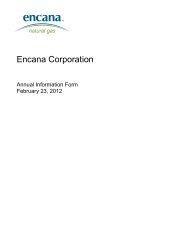Deep Panuke Project Description - Encana
Deep Panuke Project Description - Encana
Deep Panuke Project Description - Encana
Create successful ePaper yourself
Turn your PDF publications into a flip-book with our unique Google optimized e-Paper software.
week during normal operations. It is anticipated that there will be approximately six trips a week duringconstruction and heavy maintenance periods. In addition, a standby vessel is required near the platformat all times as per CNSOPB regulations.2.4.3.2 HelicoptersPersonnel will be transported to and from the offshore facilities via helicopters from the heliport locatedat the Halifax International Airport. During pipelay and heavy lift activities, the frequency of helicopteractivity is estimated to be two to three trips per week. During hook-up and commissioning, thefrequency is estimated to be seven to ten trips per week. The frequency will reduce to approximately sixto ten flights per month during operations. These helicopters are used primarily to transport crewmembers, company personnel and service personnel. In some cases, small equipment and parts aretransported via air transportation.2.4.4 <strong>Project</strong> Safety ZonesEnCana will consult with the appropriate regulatory authorities to develop a safety zone around the<strong>Deep</strong> <strong>Panuke</strong> facilities in accordance with the Nova Scotia Offshore Petroleum Drilling Regulations andthe Nova Scotia Offshore Area Petroleum Production and Conservation Regulations. This zone willinclude, as a minimum, an area extending 500 m around the MOPU and will likely also include theinterfield flowlines and wellheads. The exact configuration of the safety zone will be determined basedon safety risk assessment studies and consultations with the regulatory agencies. There will also be atemporary 500 m safety zone around the drilling rig when it is on location for development drilling. ANotice to Mariners will be issued and appropriate mariner charts will be updated for the installationsthrough the Canadian Hydrographic Service.Standard operating procedures will be developed to lessen the risk of collisions between ships and<strong>Project</strong> infrastructure. These would include, but are not limited to, the following:• presence of structures and safety zones would be indicated on nautical charts;• Coast Guard Notice to Mariners would apply during construction; and• radio operators would notify approaching vessels of the presence of the structures. The distanceat which mariners would be notified would be dependent on a number of factors, including thedirection and speed of the approaching vessel and weather conditions.Although there are no regulations under the CNSOPB that provide a similar safety zone around apipelaying vessel, EnCana will request the Coast Guard issue a Notice to Mariners with regard to thistemporary construction activity. Mariners will be informed as to the status of the pipelaying operationand the vessels taking part in the activity. The export pipeline’s design takes into consideration fishingactivity in the area so that once the pipeline is laid, there will be no restrictions with regard to safety<strong>Deep</strong> <strong>Panuke</strong> Volume 4 (Environmental Assessment Report)• November 2006 2-43


